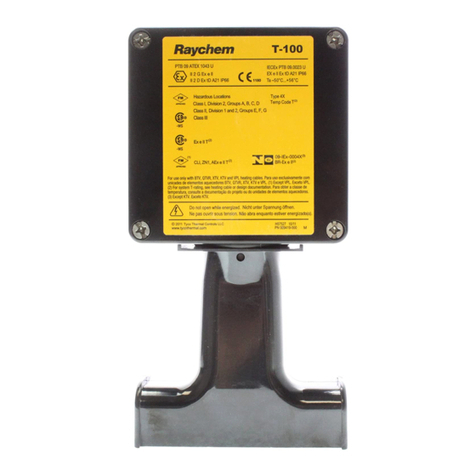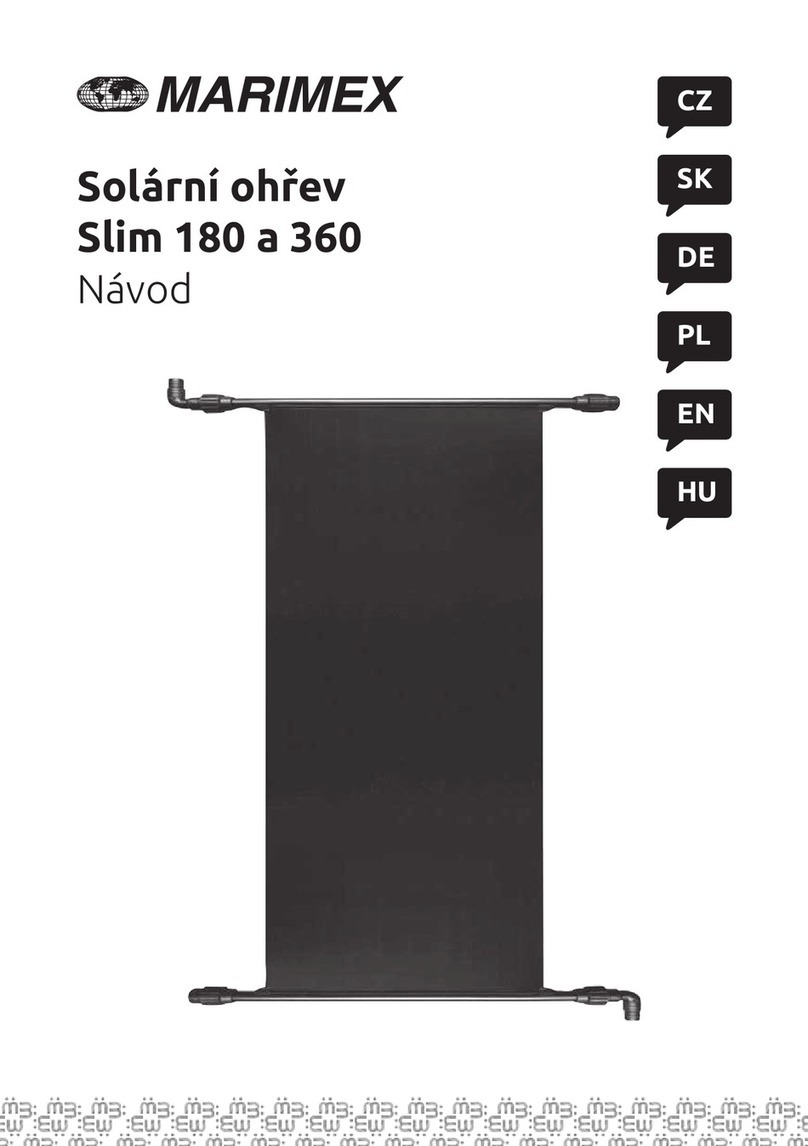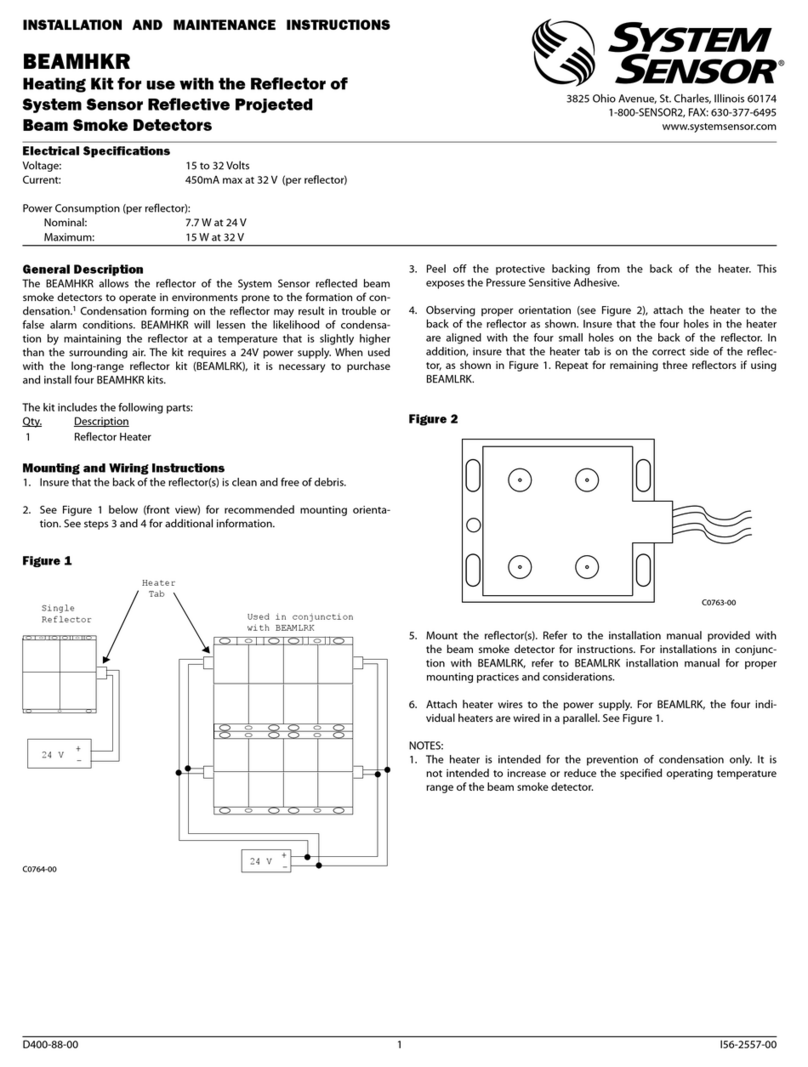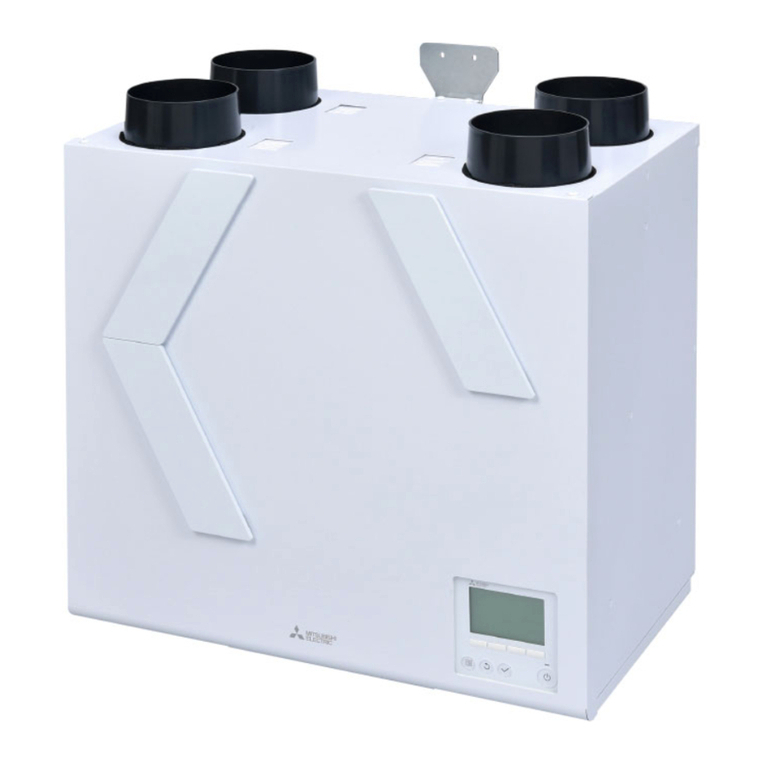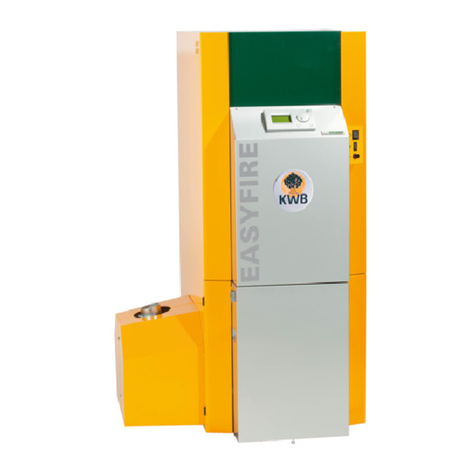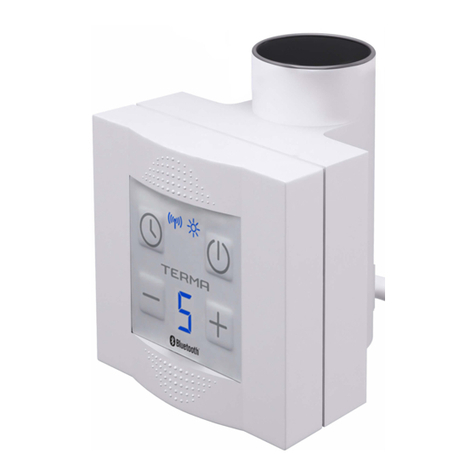Steffes ThermElect Hydronic 9150 User manual

OWNER'S AND
INSTALLER'S MANUAL
Models: 9150, 9180
Applicable to Software Version 2.XX
Hydronic
LISTED

For Customer Use
Please record your model and serial number below. This number is found on the identification labels
located on the front of and inside the electrical panel. Retain this information for future reference.
Model No. ________________________________________________________________________
Serial No. ________________________________________________________________________
RECOGNIZE THESE SYMBOLS AS SAFETY PRECAUTIONS
It is important, both for your personal safety and to avoid possible damage to the
equipment and your property, that you observe the safety instructions given follow-
ing these symbols.
w The equipment described herein is intended for installation by a quali!ed
technician in accordance with applicable local, state, and national codes and
requirements.
w To insure proper installation and operation of this product, completely read
all instructions prior to attempting to assemble, install, operate, maintain or
repair this product. Upon unpacking of the system, inspect all parts for dam-
age prior to installation and start-up.
w This manual should be retained by the owner upon completion of the installa-
tion and made available to service personnel as required.
w Disclaimer: In compiling this manual, Steffes Corporation has used its best
judgement based upon information available, but disclaims any responsibility
or liability for any errors or miscalculations contained herein, or any revisions
hereof, or which result, in whole or in part, from the use of this manual or any
revisions hereof.
IMPORTANT

SAFETY PRECAUTIONS
Fully assemble the system and load ceramic heat storage1.
brick prior to energizing the system.
Pressure relief valve must be installed prior to operation of2.
the system.
Use or storage of explosive or •ammable gasses or liquids3.
within close proximity of the system presents a hazard.
Clearance requirements are critical to safe operation of the4.
system. Follow all requirements speci•ed in this manual
(Page 3.03).
Keep the top of system clear.5.
Use caution when working around the heating system as inlet6.
and outlet piping can be very hot.
De-energize all branch circuits before servicing. This heating7.
system may be connected to more than one branch circuit.
Installation of and/or service to this heating system should be8.
performed by a quali•ed technician in accordance with in-
formation contained herein and with national, state, and local
codes and requirements.
Repeated error codes on the system display (pages A.10 –9.
A.13) indicate a need for service by a quali•ed technician.
Special requirements must be considered if placing the sys-10.
tem in a garage or other area where combustible vapors may
be present. Consult local, state and national codes and regula-
tions to ensure proper installation.
BUILT-IN SAFETY DEVICES
The ThermElect Hydronic heating system incorporates safety devices to ensure normal operating temperatures are
maintained. The chart below describes these safety devices.
THERMELECT HYDRONIC SAFETY INFORMATION
DEVICE LOCATION
ON SYSTEM
Core Charging High
Limit Switches
(Auto Reset)
These limit switches monitor the core and top temperatures.
If normal operating temperatures are exceeded, the system
will display "CORE FAIL" and the elements will not be
allowed to operate.
Right side of system.
This linear limit switch monitors the temperature of the wa-
ter in the exchanger and interrupts power to the core blower
if a water temperature of 250oF/121oC is exceeded. If this
limit switch opens, contact a quali•ed service technician.
Heat Exchanger
Limit Switch
(Manual Reset)
Behind front lower
painted panel. Reset
button visible in lower
right front corner.
This linear limit switch monitors the temperature of the
water in the exchanger and interrupts power to the core
blower if a water temperature of 225oF/107oC is exceeded.
Outlet Water
Temperature Limit
Switch (Auto Reset)
Behind front lower
painted panel.
Pressure Relief Valve Factory provided,
•eld installed to outlet
of heat exchanger.
If the water pressure exceeds maximum psig, the pressure
relief valve opens. Once water pressure of less than maxi-
mum psig is achieved, the valve closes.
FUNCTION
WARNING
Hazardous Voltage: Risk of electric
shock, injury, or death. This system
may be connected to more than one
branch circuit. Disconnect power
to all circuits before installing or
servicing. Installation of and/or
service to this equipment MUST be
performed by a quali!ed technician.
Risk of explosion. Operating the
system without the pressure relief
valve properly installed can cause
an explosion. Connect the pressure
relief valve in a vertical, upright po-
sition with the supplied !ttings. DO
NOT modify this assembly. DO NOT
cap, plug, or otherwise obstruct the
outlet of the pressure relief valve.
Risk of !re. Violation of the clear-
ance requirements can cause im-
proper operation of the equipment.
Maintain the placement and clear-
ance requirements speci!ed.
Hot Surface. Plumbing and other
surfaces can be hot. Use caution
when working near the system.

Table of Contents
TC
TABLE OF CONTENTS THERMELECT HYDRONIC
Operation
General Operation........................................................................................................................................................................1.01
System Use During Construction Phase ......................................................................................................................................1.01
System Start-Up...........................................................................................................................................................................1.01
Turning System "OFF" and "ON"................................................................................................................................................1.01
Control Panel ...............................................................................................................................................................................1.02
Operating Status...........................................................................................................................................................................1.02
Discharge Air/Water System........................................................................................................................................................1.03
Brick Core Charge Control .........................................................................................................................................................1.03
Charge Control Override..............................................................................................................................................................1.03
Maintenance and Cleaning...........................................................................................................................................................1.03
Optional Accessories
Load Management Control .........................................................................................................................................................2.01
Lifting Handles ............................................................................................................................................................................2.01
External Duct Sensor ...................................................................................................................................................................2.02
Static Heat Recovery Unit ...........................................................................................................................................................2.02
SCR Controller.............................................................................................................................................................................2.02
Control Circuit Step Down Transformer......................................................................................................................................2.03
Installation
Shipping and Packaging...................................................................................................................................................... 3.01-3.02
Placement and Clearance Requirements......................................................................................................................................3.03
Initial Set-up.................................................................................................................................................................................3.04
Electrical Panel Installation .........................................................................................................................................................3.04
Brick Loading ..................................................................................................................................................................... 3.04-3.05
Heating Element Installation............................................................................................................................................... 3.05-3.06
Brick Core Temperature Sensor Installation ..............................................................................................................................3.06
Line Voltage Electrical Connections............................................................................................................................................3.07
Low Voltage Electrical Connections
Outdoor Temperature Sensor Installation...............................................................................................................................3.08
Room Thermostat ...................................................................................................................................................................3.08
Air Conditioner/Heat Pump Interface ....................................................................................................................................3.09
Pressure Relief Valve Installation ................................................................................................................................................3.09
Plumbing..............................................................................................................................................................................3.10-3.11
Appendix
Speci!cations .....................................................................................................................................................................A.01-A.02
Exploded View Diagram - 50kW Storage Module .....................................................................................................................A.03
Exploded View Diagram - 80kW Storage Module .....................................................................................................................A.04
Parts List - Storage Module ........................................................................................................................................................A.05
Exploded View Diagram / List - Base .......................................................................................................................................A. 06
Typical System Line Voltage Wiring Diagrams ................................................................................................................A.07-A.08
Internal System Wiring Diagram - Low Voltage ........................................................................................................................A.09
Help Menu ..................................................................................................................................................................................A.10
Error Codes ........................................................................................................................................................................A.10-A.13
Warranty

GENERAL OPERATION
The ThermElect Hydronic heating system stores de-
mand off-peak electricity in the form of heat.
Operation of the heating system is automatic. During
hours when energy costs are lower the system converts
electricity to heat which is then stored in its ceramic
brick core. The amount of heat stored in the brick core
of the system varies in relation to outdoor temperature,
utility peak conditions, and/or the heating require-
ments.
A heat call from the thermostat or main system control
energizes the primary water loop pump. The vari-
able speed core blower automatically adjusts its speed
to achieve the desired outlet water temperature. The
heated water is then pumped to the area (zone) from
which the heat call originated.
The versatility of this system allows it to •t many ap-
plications. The system is designed for use as either a
sole heating source (“stand alone” furnace) for make
up air heating or as a supplement to another ducted
heating system such as a heat pump.
SYSTEM USE DURING
CONSTRUCTION PHASE
Like most heating equipment manufacturers, Stef-
fes strongly recommends that “Construction Heating
Units” be used instead of the permanent heating system
during the construction phase. Use of the permanent heating system during this phase may contaminate the duct
system and/or internal areas of the heating system. This may cause poor indoor air quality issues and/or improper
system operation or equipment damage.
SYSTEM START-UP
On start-up of the ThermElect Hydronic system, odors relating to •rst time operation of the heating components
may be experienced. Allow the system to charge to its maximum brick core charge level, on start-up, to expel
these odors. If the system has not been used for an extended period of time, dust may accumulate in the system.
Upon restart, there may also be an odor as these dust particles are expelled.
During operation, the system may produce minor expansion noises. These noises are the result of the internal com-
ponents reacting to the temperature changes.
TURNING SYSTEM "OFF" AND "ON"
The system is fully automatic and does not need to be manually disabled. Talk to your installer or energy manage-
ment person for additional information.
THERMELECT HYDRONIC OPERATION n1.01
Operation
1
Operation
SUPPLY
WATER
WATER
RETURN
VARIABLE SPEED
CORE BLOWER
MOTOR ASSEMBLY
225° AUTO
RESET LIMIT
250° MANUAL
RESET LIMIT
AIR TO WATER
HEAT EXCHANGER
HEAT
STORAGE
BRICK
HEATING
ELEMENT

CONTROL PANEL
Operation of the ThermElect Hydronic system is automatic. All operational func-
tions are stored in its microprocessor in function locations and are factory preset. If
necessary, the installer can adjust them through the control panel. (See Figure 1.)
Four-Digit LED Display
The four digit LED displays speci!c operating information. During the con!gura-
tion process, the con!guration number and the values set in these con!gurations are
displayed for viewing and adjusting purposes.
AM and PM Indicator Lights
The AM and PM indicator lights are only utilized if the Steffes Time Clock Module
is being installed and using 12 hour time display. With this module installed,
the system displays time on AM/PM intervals. The light "ashes next to the ac-
tive designator/symbol. The system can be con!gured to display military time,
in which case both the AM and PM lights illuminate.
Mode (Edit) Button
Used to access menus on the system (i.e. Help Menu or Con!guration Menu)
and to allow modifying of con!guration settings.
Up and Down Arrow Buttons
Used to scroll up or down when viewing or modifying operating functions.
Interface Port
Allows technician external access for advanced operating modes, updating software, and troubleshooting.
OPERATING STATUS
The four digit LED will display various operating information as described below. Press and release the up arrow
to view this data.
Operating Mode - Indicates the current operating mode of the system followed by the outlet
water temperature.
C = Off-Peak (Charge) Time
P = On-Peak (Control) Time
A = Anticipated Peak Time
Outdoor Temperature -“O” followed by a number indicates current outdoor temperature.
Heat Call Status - indicates the current heat call status as determined by the room thermostat(s).
The faceplate displays the highest heat call value present. If receiving a Stage 1 Forced Air Heat
Call and a Hydronic Heat Call, the display will read “HC_3”.
A bar illuminates on the lower portion of the display's third digit whenever one or
more heating elements are energized.
Brick Core Charge Level - “CL” (charge level) followed by a number indicates the current per-
centage of heat stored in the brick core. “CL:_” indicates the core is below minimum charge level
and “CL: F” represents a full core charge level.
Targeted Brick Core Charge Level - “tL” (target level) followed by a number indicates the cur-
rent percentage of brick core charge being targeted by the system. A display of “tL:_” indicates
charging is not allowed and “tL: F” indicates a full core charge target level.
Load Control - Current demand (kW) divided by 10. A value of “d 75” is equal to a demand of
750kW.
OPERATION n1.02 THERMELECT HYDRONIC
CAUTION
Editing configuration
information may alter
the performance and
operation of the system.
Operation
ñò
M
CONTROL PANEL
FIGURE 1
MM
PP
M
MM
AA

THERMELECT HYDRONIC OPERATION n1.03
DISCHARGE AIR/WATER SYSTEM
The 9100 Series heating systems can be used as straight hydronic heating appliances or as a combination hydronic
and forced air system with the addition of a •eld supplied air handler, water coil, and duct sensor. In all systems, to
deliver stored heat, the 9100 Series needs to receive a signal from a thermostat, BACNet system, energy manage-
ment system, or serial communication input. This signal will initiate one of several levels of heat call.
When a heat call is initiated, the system displays the type of heat call on the status screen of the control panel, the
primary loop pump is energized, and the outlet water temperature is monitored. The desired discharge water tem-
perature is regulated based off of the target temperature (L127) established.
BRICK CORE CHARGE CONTROL
Steffes heating systems are capable of providing a wide variety of heating options for various applications. The
heating system's primary function is to store energy in the form of heat. Because the system is operated with mi-
croprocessor based control, it is very flexible in meeting the demands of the application. The rate at which energy
is stored can be controlled with BACNET, 4-20, or pulse inputs.
The amount of energy stored is based on the target level which is determined by outdoor temperature, utility peak
conditions, building automation system, and/or the heating requirements. Sensors monitor the brick core tempera-
ture and communicate this information to the processor control board. If the current charge level is lower than the
target level of any core, elements will be energized as allowed by the load management system.
CHARGE CONTROL OVERRIDE
If desired, the ThermElect Hydronic system can be programmed to allow a charge control override. This override
allows the user to force the system to target a full core charge level and can be initiated or cancelled at any time. If
an override is initiated, the system targets a full core charge level during the next off-peak period. It continues to
charge during off-peak hours until it achieves full (maximum) core charge or until the override is cancelled. Once
full charge is achieved or the override is cancelled, the system charges according to the standard configuration.
MAINTENANCE AND CLEANING
Any air filter(s) in the system should be replaced on a regular basis to ensure proper operation and to maintain
overall efficiencies. No additional routine maintenance is required.
If utilizing a heat pump or air conditioning system with the ThermElect Hydronic system, the indoor coil should
be cleaned periodically as dirt accumulation may reduce system efficiency. It is important to follow the manufac-
turer’s maintenance and cleaning recommendations for these devices.
Operation

LIFTING HANDLES
LOAD MANAGEMENT CONTROL
The system is designed to operate under one of many load management control strategies.
1. BACNet Control
Steffes commercial heating furnaces are available with a BACNet control option
(Order Item #1301013 or #1301015). This device is easily integrated into most
building automation systems to provide building managers full control and vis-
ibility of the heating system’s operation. BACNet allows the following functions
to be monitored with simple, twisted pair communication:
Real time system monitoring•
Full thermostat control•
Monitoring of heat storage levels in the brick and all system temperatures•
Remote con!guration, testing and adjustment•
Service requirement alerts•
2. 4-20 Milliamp Control (1-5 volt DC)
System receives a signal from an external load control device such as a building load management
system. This external signal dictates the maximum amount of energy which can be consumed dur-
ing a preset time interval.
3. Pulse Monitoring
System monitors pulse outputs from the power company's electric meter. Program parameters such
as desired maximum building kW and pulse ratios for the metering system being used are pro-
grammed into the ThermElect system. The system then charges proportionally when demand free
power is available. This keeps the total building kW usage at or below the desired level.
4. Conventional Peak Control
The ThermElect Hydronic system responds to heat calls during the on-peak and off-peak periods;
however, only consumes energy (energize heating elements) during the off-peak periods. The
ThermElect Hydronic system is controlled by an external control device such as a meter, time clock
module, or BACNet control.
LIFTING HANDLES
Optional lifting handles (Order Item #1302120) are available to aid in moving the
ThermElect Hydronic system into its !nal location.
Optional Accessories
2
Accessories
OPTIONAL ACCESSORIES n2.01 THERMELECT HYDRONIC
BACNET

Accessories
THERMELECT HYDRONIC OPTIONAL ACCESSORIES n2.02
EXTERNAL DUCT SENSOR
The optional external duct sensor (Order Item #1041536)
provides the ability to monitor the duct temperature at an area
beyond fresh air makeup and/or beyond other devices and
regulate the discharge air temperature accordingly.
The duct sensor feature is enabled if the 4 bit is set in Location
53 (L053). Once enabled, the ThermElect Hydronic system
monitors temperature at both the duct sensor and the output
sensor during Y, W, or E calls from the thermostat.
STATIC HEAT RECOVERY UNIT
During operation of the ThermElect Hydronic, there is some static dissipation that
comes off of the warm outer panels. The Static Heat Recovery unit (Order Item
#1302110) moves this heat from the ThermElect Hydronic system to an area requiring
heat. Utilizing this option can maximize ef!ciency when the system is installed in an
unheated area.
With the Static Heat Recovery unit installed, the ThermElect Hydronic system can be
set up to monitor temperature at the control board and/or in the brick core. If either of
these temperatures reach a point greater than the preset point, the blower is the Static
Heat Recovery unit is energized and draws heat from inside the painted outer panels of
the ThermElect Hydronic system and delivers it to the desired area of the structure.
SSR CONTROLLER
The Steffes SSR (Solid State Relay Panel) is an optional control device used with the
Steffes ThermElect 9100 Series and Comfort Plus Commercial (6100 and 7100 Series)
Heating Systems (Order Item #1301016). Refer to the Owner's and Installer's Manual to
verify compatibility for the application.
It utilizes SSR technology to enable more precise balancing of a building’s overall elec-
tric load by varying the amount of total element input that can be energized in a Steffes
furnace at any given time in relation to the maximum allowable building load. The Stef-
fes SSR optimizes a building’s power quality and control.
The SSR Controller can only accept input signals from the Steffes furnace; but, it can
respond to all types of control inputs to include 4 – 20 Milliamp, 1 – 5 Volt DC, electric
meter pulsing, BACNnet or other building energy management system. With the 4 –
20mA or 1 – 5 volt DC signals, the SSR will provide an output directly proportional to
the input signal. 4mA signal produces 0% output while a 20mA signal produces 100%
output. With the utility pulse meter input, the SSR output percentage will automatically
adjust to maintain a total maximum system load as dictated by the furnace’s set-up.
SENSOR
AIR HANDLER
9100 SERIES
THERMELECT
WATER
COIL
SSR CONTROLLER

CONTROL CIRCUIT STEP-DOWN TRANSFORMER
The internal controls and motors of all ThermElect systems operate at 240 volts (two wire). In systems with
277/480 or 347/600 volt element circuits, a transformer must be installed per the installation instructions to sup-
ply this voltage to the system’s controls. This transformer can be purchased as an optional device from Steffes
Corporation or sourced from your local electrical supply outlet. See the matrix below for proper sizing. load as
dictated by the furnace’s set-up. With a Bacnet, the furnace can be commanded to varying input levels remotely.
Accessories
OPTIONAL ACCESSORIES n2.03 THERMELECT HYDRONIC
Model
Primary
Voltage
Secondary
Voltage
KVA
Hevi Duty Item #
Steffes
Item #
277/480V
480
240
2
HS1F1BS or equal
1017082
347/600V
600
240
2
HS10F2AS or equal
1017080

Installation
3
SHIPPING AND PACKAGING
The ThermElect Hydronic system should always be transported in an upright position to avoid damage to internal
components and insulation materials. The left and right side panels and the top panel should not be removed from
the Storage Module. The information below describes the items shipped with each system.
1STORAGE MODULE
MODEL INPUT
9150 53kW
9180 80kW
INSTALLATION HARDWARE KIT
(shipped
inside the
electrical
panel)
7
HEATING ELEMENTS
WITH CERAMIC INSULATORS
6
INFORMATION PACKAGE
(includes Owner's Manual and Warranty Registration Card)
(included on pallet with the electrical panel )
5
ELECTRICAL PANEL
3
MODEL ELEMENTS
9150 12 (2 boxes of 6)
9180 18 (3 boxes of 6)
(shipped separately)
(includes electrical
panel mounting
screws, romex con-
nectors, and wiring
schematic)
4
PRESSURE RELIEF VALVE
(shipped behind the
exchanger access
panel)
Refer to Page 3.09
208/240V shown
SEAM TRIM
(shipped inside brick
storage module)
8
2BASE
Installation
THERMELECT HYDRONIC INSTALLATION n3.01

SHIPPING AND PACKAGING CONTINUED...
CORE THERMOCOUPLES
9
9150 = Qty 2
9180 = Qty 3
CERAMIC BRICK
(shipped inside the
electrical panel)
OUTDOOR TEMPERATURE SENSOR
12
10
(shipped inside the electrical panel)
TOP AIR CHANNEL BLOCK
(shipped separately)
11
13 TRANSFORMER CONDUIT ASSEMBLY
(277V & 347V SYSTEMS ONLY)
Installation
INSTALLATION n3.02 THERMELECT HYDRONIC
MODEL BRICK LBS PALLETS
9150 192 3,360 2
9180 288 5,040 3
96 brick per pallet (shipped separately)
(shipped inside the electrical panel)

PLACEMENT AND CLEARANCE REQUIREMENTS
The system dimensions and required clearances MUST be taken into
consideration when choosing its location within a structure. (See
Figure 2 for dimensions and clearance requirements.)
The best installation location for the system is in a space requir-
ing heat so some amount of the heating requirements can be satis-
•ed through static dissipation from the warm outer panels of the
ThermElect Hydronic system. In situations where the system is not
installed in an area it is intended to heat (i.e. garage or storage area),
it is important to account for the heat lost through static dissipation
by making proper adjustments when sizing the system.
This area must remain free of debris and most importantly the
room air should be maintained at less than 85oFahrenheit. Area
may require ventilation. Refer to Speci•cations (Pages A.01-A.02).
It is the responsibility of the installer and system designer to provide
this ventilation.
In addition to the physical space requirements, the weight of the system must also be taken into consideration when
selecting the installation surface. A level concrete floor is the designed installation surface, but most well supported
surfaces are acceptable. If unsure of floor load capacity, consult a building contractor or architect.
Special requirements must be considered if placing the system in a garage or other area where com-
bustible vapors may be present. Consult electrical, building, and !re prevention codes.
SYSTEM REQUIREMENTS
FIGURE 2
DIMENSIONS
Some electrical codes may require a greater front and/or left side
clearances depending on operating voltages and other factors.
CLEARANCES
wBack = 8 inches
wBottom = 1 inch (from combustible material)
wRight Side = 12 inches
wTop = 8 inches (from combustible material)
wLeft Side & Front = 36 inches (for ease in servicing)
Adhere to clearances and provide appropriate ventilation to maintain
no greater than 85oF air temperature in area where system is installed.
Risk of •re. Can cause injury or death.
Violation of the clearance require-•
ments or failure to provide proper
ventilation can cause improper op-
eration of the system. Maintain the
placement and clearance require-
ments as speci•ed and provide
ventilation as necessary.
Moving the system after install•
may result in equipment damage.
Do NOT move system from original
installed location.
WARNING
34"
80KW
STORAGE
MODULE
40 1
16
9180 - 98"
9150 - 77"
51"
36" MINIMUM
CLEARANCE
36" MINIMUM
CLEARANCE
1" CLEARANCE
REQUIRED
8" MINIMUM CLEARANCE
12" MINIMUM
CLEARANCE
36" MINIMUM CLEARANCE
8" MINIMUM CLEARANCE
12" MINIMUM
CLEARANCE
Installation
THERMELECT HYDRONIC INSTALLATION n3.03

INITIAL SET-UP
Step 1 Remove the Information Package from the outside of the elec-
trical panel and unpackage the storage module and base.
Step 2 Move the base of the ThermElect system into location.
Step 3 Level the base ensuring the leveling legs are in full contact
with the floor so the base does not rock. The legs cannot
extend more than 1”.
Step 4 Remove the painted front and back panels of the storage mod-
ule. The right and left sides and the top panels should not be
removed from the storage module
Step 5 Position the brick storage module onto the base, making sure
the square holes (front) in the base line up with the square
holes of the storage module.
Optional lifting handles are available from Steffes
(Order Item #1302120).
Step 6 Reinstall painted back panel and attach right and back side seam trim using hardware provided.
Installation
ELECTRICAL PANEL INSTALLATION
Step 1 Remove the electrical panel front cover and locate the installation hardware package.
Step 2 Remove 1" trade size knockouts from the electrical panel and the ThermElect Hydronic's left side
panel to allow routing of element harnesses. DO NOT remove any unneeded knockouts.
Step 3 Remove 1/2" trade size knockout for routing of control wiring.
Step 4 Secure the electrical panel to the left side of the system with the 8 x 3/4" sheet metal screws supplied
in the electrical panel.
Knockouts must be effectively sealed by connectors.
BRICK LOADING
Step 1 Remove the seam trim from inside the storage module and
set aside.
Step 2 Remove the sheet metal screws around the outer edge of
the galvanized front panel. Remove the panel and set it
aside.
Step 3 Starting at the bottom, carefully lift the insulation blankets
and drape them over the top of the system.
Use and follow generally accepted safety practices
when handling insulation materials.
Step 4 Cut banding and remove the two packages of rigid insulation from inside the storage module. One of
the packages contains the back rigid insulation (no holes) and one package contains the front rigid
insulation (with holes).
CAUTION
Risk of improper operation or equipment damage. Read and follow installation instructions carefully.
• Remove system from shipping pallet prior to !nal placement.
• Ensure that leveling legs make solid contact with "ooring and do not extend more than 1 inch.
• Use and follow generally accepted safety practices when handling insulation materials.
• Equipment MUST be installed by a quali!ed technician in accordance with all applicable codes
and regulations.
WARNING
HEAVY OBJECT WARNING:
Risk of personal injury, or death.
ThermElect Hydronic systems
are heavy. Use lifting aids to
move system into place.
w Do not place object, hands,
and/or body parts under the
system when lifting.
w Do use care to keep objects,
hands, and/or body parts
clear of system when lifting.
Risk of equipment damage or
personal injury. Insulation boards
located behind the insulation blankets
may fall out when blankets are lifted.
Use caution when lifting insulation
blankets to avoid personal injury or
damage to the insulation boards.
CAUTION
INSTALLATION n3.04 THERMELECT HYDRONIC

Step 5 Locate and install the back rigid insulation inside the brick storage module. It will
be placed on top of the existing rigid insulation at the back of the module. The
angled edge will line up with the existing rigid insulation.
Step 6 Load the brick, one row at a time, starting at the back of the brick core and work-
ing forward. Load bricks as shown in Figure 3. Make certain brick debris does
not interfere with brick alignment front to back.
Step 7 Install top air channel block by sliding it up and
back into place on top of the bricks. (See Figure 4.)
For ease of installation, install top block
while loading bricks.
Step 8 Install the front rigid insulation (with holes) in front
of the bricks. Again, the existing angled rigid insula-
tion will line up with the front angled rigid insula-
tion.
The holes in the rigid insulation board
MUST line up with the brick openings so
elements can be installed.
Installation
HEATING ELEMENT INSTALLATION
Proper heating element installation is important to operation
of the system. Reference the "Useful Tools" section of the
Heating Element Service and Repair Guide included with the
heating elements for more information.
Step 1 After all bricks are loaded and rigid insulation boards
are in place, insert the heating elements through the
insulation, sliding them in until the cement side rails
are flush with the front side of the ceramic brick.
Make sure the elements designated as
"outer" elements are installed on the
electrical panel side of the system with
the shortest lead in the left most brick
position.
Step 2 Route the element termination lead with ceramic
insulator to the appropriate side of the system.
Insert the lead into position as shown in Figure 5.
Element leads must never cross each
other.
Step 3 Install element lead insulators. These ceramic insulators MUST maintain lead wire spacings as shown in
Figure 6.
Risk of •re. Can cause personal
injury or death. DO NOT operate
the Comfort Plus Hydronic system
if damage to the insulation panels
on the inner sides of the brick core
occurs.
WARNING
FIGURE 4
HAZARDOUS VOLTAGE: Risk of electric
shock. Can cause injury or death.
w DO NOT remove the electrical panel
cover while system is energized.
w Elements MUST be positioned prop-
erly to avoid short circuiting against
any surfaces within the system.
WARNING
FIGURE 6
BRICK INSTALLATION TIPS:
•Install bricks carefully to avoid damage to the insulation panels.
•Remove loose brick debris to prevent uneven stacking of brick as
this can make installation of the elements and the brick core tem-
perature sensor(s) dif#cult.
•Brick rows MUST line up front to back and top to bottom.
FIGURE 5
BRICK LOADING
FIGURE 3
THERMELECT HYDRONIC INSTALLATION n3.05

Step 4 Lower insulation blankets back into position, one at a time. Carefully tuck the sides of the insulation into
the edges, corners, and around the exposed portions of the heating element to ensure maximum ef•ciency.
Use face mask, gloves, and long sleeved garments when handling insulation materials in ac-
cordance with generally accepted safety practices.
Step 5 Reinstall the galvanized front panel and secure it to the system using the screws originally removed.
Step 6 Route element harnesses through connectors, using one connector/harness until tape is centered.
Step 7 Attach element lead wires to element terminals. Start at the top using the appropriate color chart below.
Repeat pattern as necessary. The neutral white wires are jumpered together in sets of three.
277/347V = Black (Top) 208/240V = Black (Top) 240V = Black (Top)
Systems White 3phase Red 1phase Red
Red Systems Blue Systems Black
White Black Red
Blue Red
White Blue
Step 8 Route the orange wire to the electrical compartment. Cut the wire and crimp ends (found on orange/
black wires in electrical compartment). Connect the orange wires to the orange/black wires.
Step 9 Remove the blower access cover from the base left side. Locate the blue core blower wires and purple
(violet) water temperature sensor wires.
Step 10 Route the wires through the flanged hole at the front left corner of the base. Continue routing up to the
electrical compartment through 1/2" knockout. Connect the blue core blower wires to black and the blue
wires. Connect the two purple (violet) wires to the two purple wires..
Step 1 Remove the screw(s) by the brick core temperature sensor con-
nector holes in the galvanized front panel.
Step 2 Route the brick core sensors through the 1/2" knockout up to
the relay driver board. The yellow wire from each sensor must
be connected to the Y terminal of the proper sensor connection
terminal block, and red to R. Polarity of sensors is critical.
Sensor connections MUST be installed as follows:
• Single Module - 9150 or 9180 (Figure 7)
• Bottom sensor to core C
• Second sensor to core D
• Third (if equipped) to core E
Step 3 Insert the brick core temperature sensors through the holes in
the galvanized front panel. The sensors must pass through the
blanket and board insulation and into the brick core. Use the
sensors to aid in making a passageway by rotating the sensors
while gently pushing inward.
Step 4 Once brick core sensors are installed, re-install sensor mount-
ing screws to secure and ground the sensors.
Risk of improper operation. Proper installation of the brick core temperature sensor is critical to
the operation of the heating system. Read and follow installation instructions carefully.
CAUTION
CORE TEMPERATURE SENSOR
CONNECTIONS
FIGURE 7
Core
Temperature
Sensors
Connect To Core "E"
On 80kW Module Only
Relay
Driver
Board
Connect To
Core "D"
Connect To
Core "C"
Installation
INSTALLATION n3.06 THERMELECT HYDRONIC
BRICK CORE TEMPERATURE SENSOR INSTALLATION

Installation
LINE VOLTAGE ELECTRICAL CONNECTIONS
To determine the correct wire size required for the circuit feeding
the system, refer to the Speci•cations (Page A.01-A.02) and the
system's identi•cation label located on the cover of the electrical
panel (Figure 8).
Step 1 Remove the electrical panel cover if not already removed.
Step 2 277/347 only. Mount the dry type enclosed transformer
below the electrical panel on the system's painted left
side. Use a 1/2" knockout from the bottom left side of the
electrical panel.
Install only the proper size and type fuses in
the factory supplied fuse block.
Step 3 Route all supply circuit •eld installed conductors through
a knockout and into the electrical panel.
Use copper or aluminum conductors rated at
75oC or higher for line voltage !eld connection
of this device.
Step 4 Make line voltage connections to lugs of single feed bus and ground lug. Refer to the Line Voltage Wiring
Diagrams (Pages A.07 - A.08) for more information on these connections.
CONNECTION OF PRIMARY LOOP PUMP
In 277/347 volt installations, a 120 or 240V single phase pump can be used. Connect the pump only to terminals
inside the electrical panel marked for connection of the primary loop pump as shown in Figure 9B.
• A 240V pump is required for 208/240V applications
(Figure 9A) as no neutral terminal is provided.
• Do not use pumps with relay outputs or electronics
• Total rating of all connected pumps cannot exceed
1.2 amps on each pump output.
• Make wiring connections according to manufac-
turer's instructions and appropriate line voltage
wiring diagram.
SAMPLE SYSTEM IDENTIFICATION LABEL
FIGURE 8
w
HAZARDOUS VOLTAGE: Risk of elec-
tric shock, injury or death. Do not
energize the system until installation is
complete. Equipment MUST be installed
by a quali•ed technician in accordance
with all applicable local, state, national
codes and regulations.
w Risk of equipment damage, personal
injury or •re. Do NOT install any wir-
ing in line voltage compartment unless
rated for line voltage. To ensure proper
operation and safety, all wiring in the
line voltage compartment MUST be
rated for line voltage.
WARNING
THERMELECT HYDRONIC INSTALLATION n3.07
FIGURE 9
(277/347V Shown)
}
}
Neutral
Recovery Unit (240V)
Optional Static Heat
Secondary Pump Power
(Variable Speed)
Primary Pump
TRANSFORMERS
240v / 24v
COM
NO COM NO
NONO
1/4 Amp
COM COM
Transformer
120/240 VAC
BASE IO BOARD
EXCHANGER
LIMITS
N.C.
AUTO
DAMPER
RESET
225 °
MANUAL
COM.
WHITE
HIGH
RESET
250°
N.C.
L2 120
L1
L2 240
BLOWER
RESISTER
L1L2
Neutral
Power (240V)
}
Power (240V)
}
}
}
Recovery Unit (240V)
Optional Static Heat
Secondary Pump Power
(Variable Speed)
Primary Pump
Ground
4uf
Cap.
ORANGE
PRIMARY PUMP POWER
(VARIABLE SPEED)
SECONDARY PUMP POWER
OPTIONAL STATIC HEAT
RECOVERY UNIT (240V)
NEUTRAL
(240V)
}
}
}
RESISTER
RED
BLUE
BLACK
5 Amp
Secondary
CORE
BLOWER
Element Relay
Neutral
#11 Right
#11 Right
Element
Element Relay
#12 Left
Ground
Lug
#12 Left
Element
Element Relay
Element Relay
Element Relay
Element
#7 Right
Element
#9 Right
#7 Right
#9 Right
#5 Right
Element Relay
Element Relay
Element Relay
#10 Left
#8 Left
#6 Left
#3 Right
Element Relay
Element
#1 Right
Element
#3 Right
#1 Right
Element Relay
#5 Right
#4 Left
Element Relay
#2 Left
Element Relay
Element
Element
#2 Left
Element
#4 Left
Element
#8 Left
#10 Left
Element
#6 Left
Element
9A - 208/240V 9B - 277/347V

LOW VOLTAGE ELECTRICAL CONNECTIONS - OUTDOOR
TEMPERATURE SENSOR (OPTIONAL)
If using BACNet control, the outdoor temperature sensor may not be used. Follow the in-•
structions included with the BACNet Controller.
If connecting to the Steffes power line carrier (PLC) system, follow the installation instruc-•
tions in the PLC system's Owner's and Installer's Guide.
Outdoor sensor wire MUST NEVER be combined with other control wiring in a multi-con-•
ductor cable.
Theory of Operation: The outdoor sensor monitors outdoor temperature and provides this information to the
system. The system responds by automatically storing heat in its brick core according to
outdoor temperature and the heating requirements.
Location of: The outdoor sensor must be placed in a location where it can accurately sense outdoor temperature
and is not affected by direct sunlight or other abnormal temperature conditions.
Installation Methods: A) Hard wired to Steffes heating system "OS" and "SC" terminals (default)
OR
B) Connected to Power Line Carrier (PLC)
Wiring: • Route low voltage wire from the outdoor sensor to the electrical compartment through one of the
low voltage wire knockouts.
• Connect to "OS" and "SC" as shown in Figure 10.
• If the sensor wiring is routed through an external wall, the opening through which the wire is routed
MUST be sealed. Failure to do so may affect the accuracy of the outdoor temperature sensor.
• The outdoor sensor is supplied with a lead length of 40 ft. If a greater wire length is needed, it can
be extended to a total of 250 ft.
• No other loads can be controlled or supplied through this cable. It is for connection of the outdoor
sensor ONLY.
• This low voltage cable MUST not enter any line voltage enclosure.
• Unshielded Class II (thermostat) wire can be used as extension wire provided it is segregated from
any line voltage cabling.
LOW VOLTAGE ELECTRICAL CONNECTIONS - ROOM
THERMOSTAT (OPTIONAL)
A low voltage (24VAC) room thermostat can be used for room temperature control with the ThermElect Hydron-
ic system. If so, Steffes recommends using a digital thermostat. To iniate a heat call, the system needs a switch
closure from R to H. This energizes the primary loop pump outputs.
12-Position Low Voltage Terminal Block Coding
R = Low Voltage Hot
C = Low Voltage Common
Y = Compressor/Stage 1 Heat Call
W = Stage 2 Heat Call
Y2 = Compressor Output
G = Fan Call
O = Reversing Valve Input
O2 = Reversing Valve Output
H = Hydronic Heat
OS = Outdoor Temperature Sensor
SC = Temperature Sensor Common
DS = Duct Temperature Sensor
Installation
INSTALLATION n3.08 THERMELECT HYDRONIC
LOW VOLTAGE CONNECTIONS
HYDRONIC HEATING SINGLE ZONE SYSTEM
FIGURE 10
Outdoor Sensor
Hydronic Heat Thermostat, Zone
Valve, End Switch, or Pump Control
SC
HOS
W
O2
O
G
Y Y2
C
R
12 Position Terminal Block
DS

Installation
THERMELECT HYDRONIC INSTALLATION n3.09
Step 1 Remove the exchanger access
panel and locate the pressure
relief valve assembly.
Step 2 Connect the pressure relief valve
to the outlet water port on the
left side of the ThermElect Hy-
dronic. It is extremely important
that the following conditions for installation of this part are met:
• Insure all connections, including the valve inlet are clean and free from any foreign material.
• Use pipe compound sparingly, or tape on external threads only.
• Mount the pressure relief valve in a vertical, upright, position directly to the outlet water port of
the system. Under no circumstances should there be a flow restriction or valve of any type be-
tween the safety relief valve and the pressure vessel.
Step 3 Use schedule 40 pipe to install a discharge line for the pressure relief valve.
This discharge line MUST:
• be connected from the valve outlet with no intervening valve and directed downward to a safe
point of discharge.
• allow complete drainage of both the valve and the discharge line.
• be independently supported and
securely anchored to avoid applied
stress on the valve.
• be as short and straight as possible.
• terminate freely to atmosphere
where any discharge is clearly vis-
ible and is at no risk of freezing.
• terminate with a plain end that is
not threaded.
• be constructed of a material suit-
able for exposure to temperatures
of 375oF or greater.
• be, over its entire length, of a pipe
size equal to or greater than that of
the valve outlet.
AIR CONDITIONER/HEAT PUMP INTERFACE
The ThermElect Hydronic system can be used in conjunction with an air conditioner or a heat pump. Contact
Steffes Corporation for more information.
PRESSURE RELIEF VALVE INSTALLATION
Available Pressure
Relief Valves
Minimum
BTU Rating
Maximum
Operating Pressure
Order
Item #
30 PSI
400,000
20 PSI
1100104
75 PSI
500,000
60 PSI
1100105
150 PSI
500,000
125 PSI
1100106
Note: 9100 Series Systems are shipped with 75 PSI pressure relief valves.
If a different valve is required order the item number listed above.
WARNING
Risk of explosion. Can cause injury or death. The factory supplied pressure relief valve MUST be
connected to the system with the supplied !ttings.
wDO NOT modify this assembly.
wDO NOT cap, plug, or otherwise obstruct the outlet of the pressure
relief valve.
wDO mount the pressure relief valve in a vertical, upright position.
wThis pressure relief valve is sized to service the needs of the
ThermElect Hydronic heating system. If multiple heating systems
are being used, pressure relief valving for the other system MUST be
provided separately.
Risk of injury or property damage. During opera-
tion, the pressure relief valve may discharge large
amounts of steam and/or hot water. To reduce the
potential for bodily injury or property damage, install
a discharge line.
wDO use schedule 40 pipe for the discharge line.
wDO NOT use schedule 80, extra strong pipe or
connections on the discharge line.
wDO NOT cap, plug, or otherwise obstruct the
discharge pipe outlet.
wDO follow all local, state, and national codes
and regulations.
CAUTION

Installation
PLUMBING
The ThermElect Hydronic system should be plumbed with a primary loop and secondary (zone) loops. The
primary loop needs to consist of a minimum of 12' of 1.25" pipe. The heat exchanger inlet and outlet are 1.5"
diameter, reducers will be required if 1.25" pipe is elected for the primary loop. The secondary (zone) loops re-
quire additional pump(s) to operate effectively. Refer to Typical Primary Loop and the Typical System Plumbing
Diagrams below for installation information.
The primary loop serves to regulate heat transfer from the system’s heat exchanger. The primary loop pump
should be powered by ThermElect Hydronic control system as shown in Figure 11. If using other control meth-
od, •ow MUST continue for at least 30 seconds at the end of a heat call.
TYPICAL PRIMARY LOOP
FIGURE 11
Air Vent
Air Separator
1
Expansion
Tank
Pressure
Relief Valve
(Factory Supplied)
Optional
Temperature and
Pressure Relief Valve
(Consult Local Code)
Inlet Outlet
*Primary
Loop
Pump
Piping MUST
Be Supported
Zone
Connection
Area
Primary Loop Pump
Control Wiring
INSTALLATION n3.10 THERMELECT HYDRONIC
TYPICAL SYSTEM PLUMBING SINGLE TEMPERATURE ZONES
FIGURE 12
Single Temperature Zone
NOTE: There are many additional ways to connect plumbing and regulate temperature from the primary loop onward.
White
Red
Primary Loop Secondary Loop
Primary
Loop Pump
ThermElect
Hydronic
Exchanger
This Valve Must
Be Open During
Normal Operation
White
Red
Primary Loop Secondary Loop
Other manuals for ThermElect Hydronic 9150
2
This manual suits for next models
1
Table of contents
Other Steffes Heating System manuals

Steffes
Steffes Comfort Plus Commercial 6140 User manual
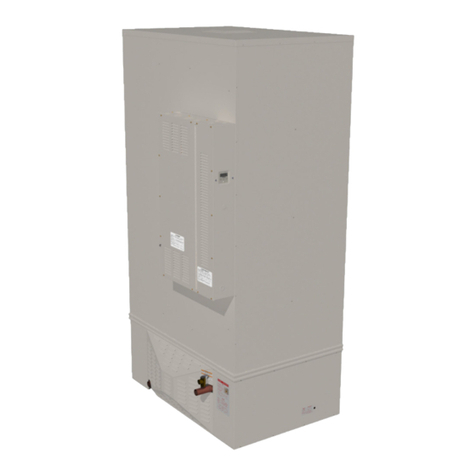
Steffes
Steffes ThermElect Hydronic 9150 User manual

Steffes
Steffes 212EXT User manual
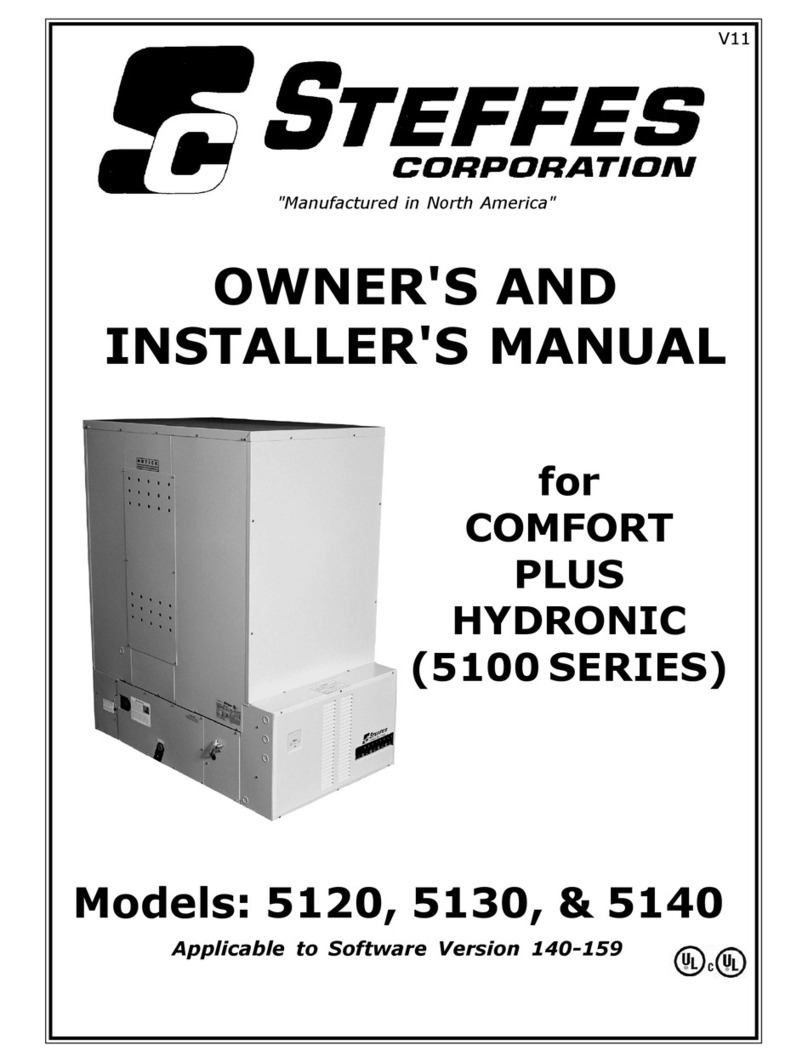
Steffes
Steffes Comfort Plus Hydronic 5120 User manual
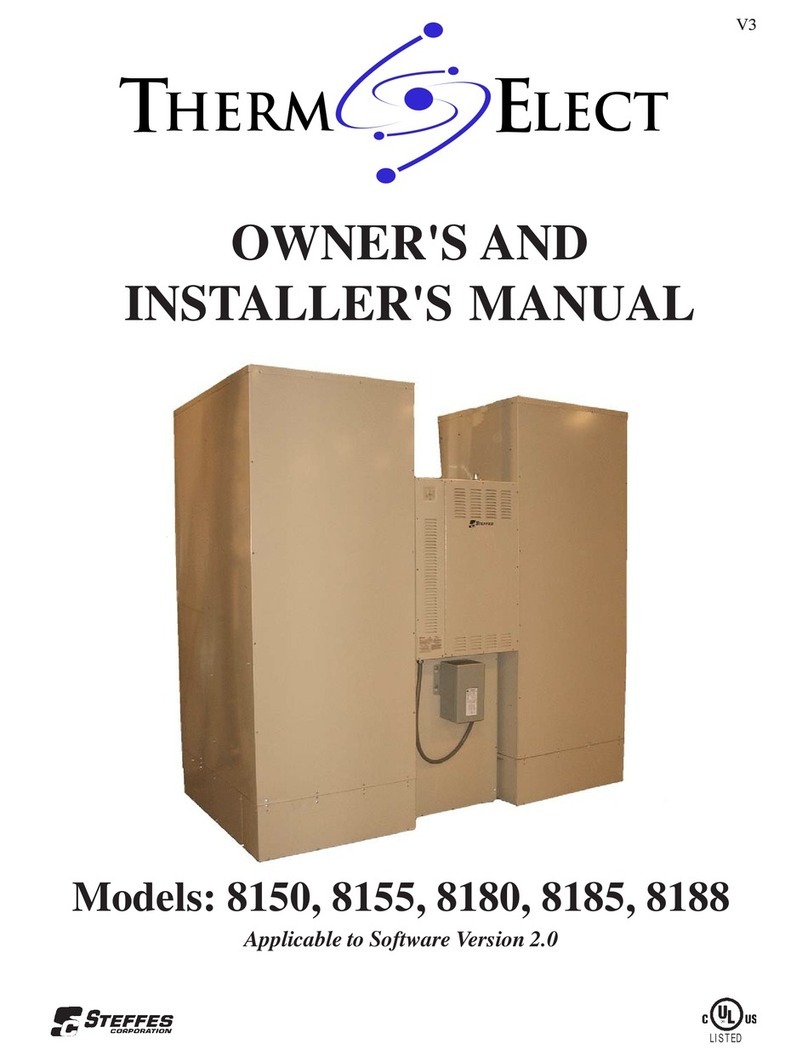
Steffes
Steffes ThermElect 8150 User manual
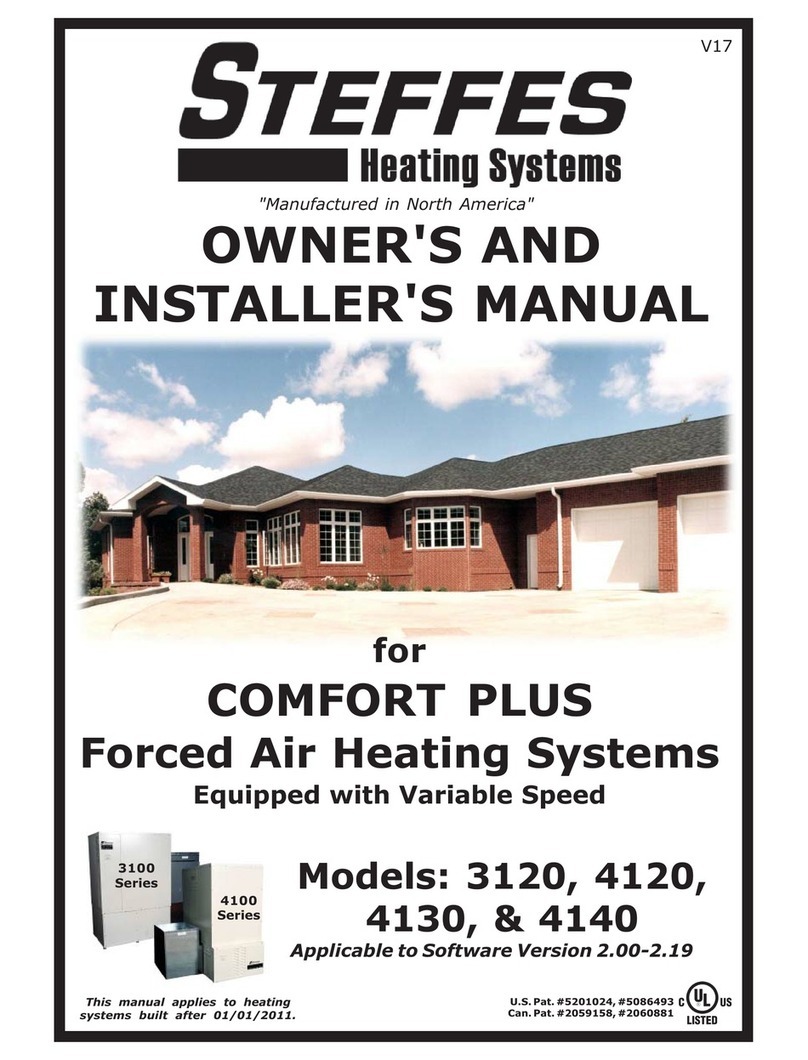
Steffes
Steffes 3100 Series User manual
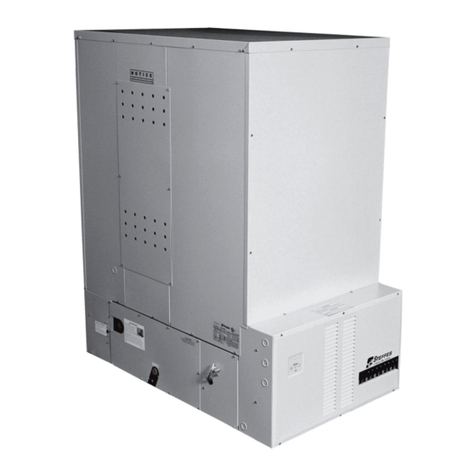
Steffes
Steffes 5120 User manual
Popular Heating System manuals by other brands
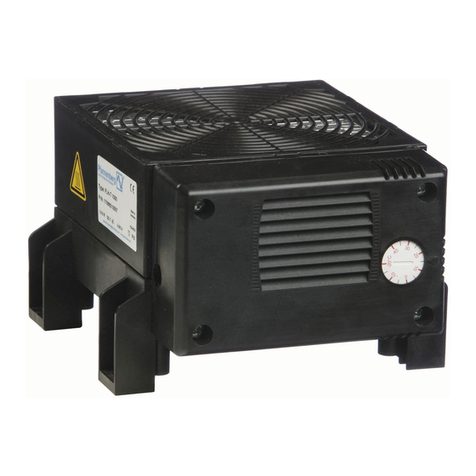
Pfannenberg
Pfannenberg FLH-T Series operating instructions

Carrier
Carrier 48DT Series installation instructions

elec-trace
elec-trace Cable Heating Floor System installation manual
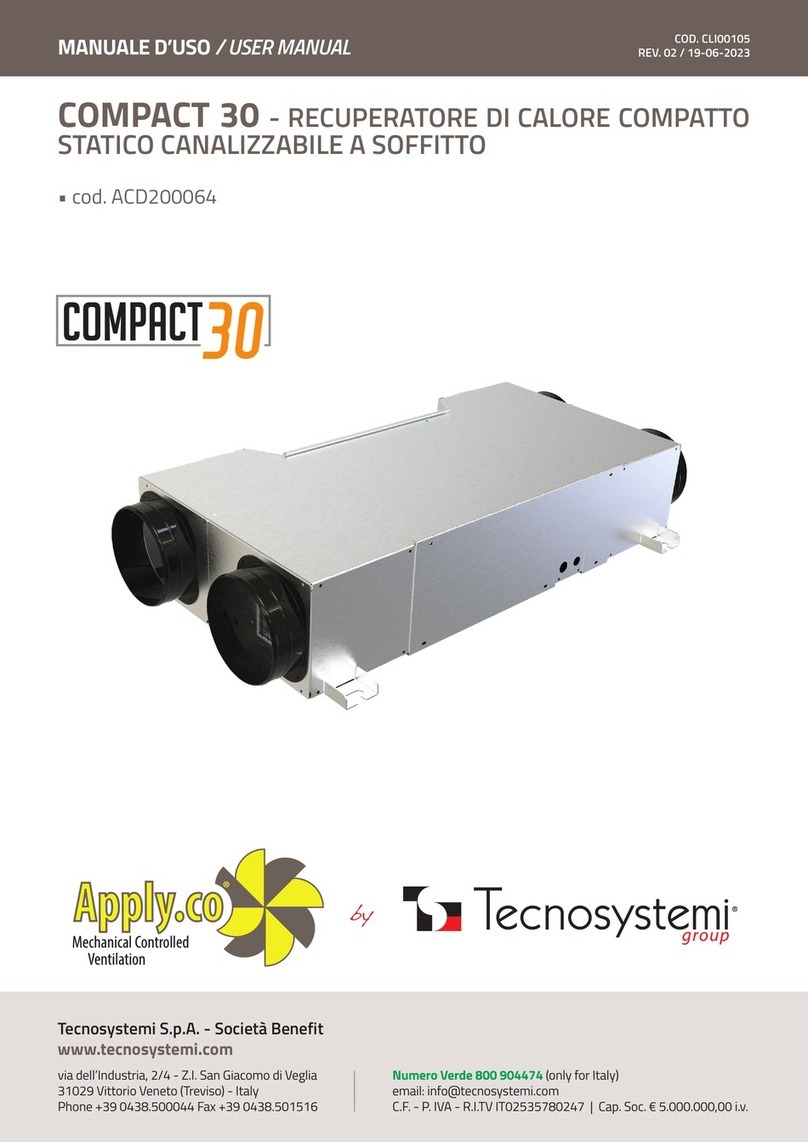
Tecnosystemi
Tecnosystemi COMPACT 30 user manual
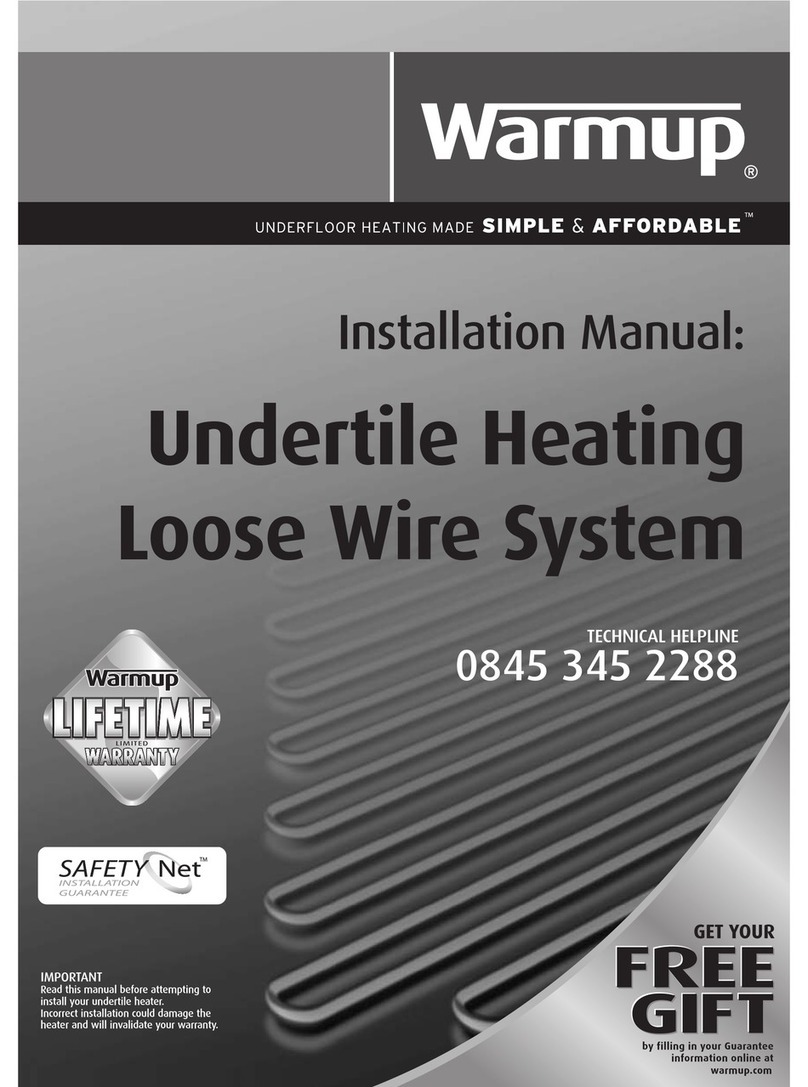
Warmup
Warmup DWS300 installation manual
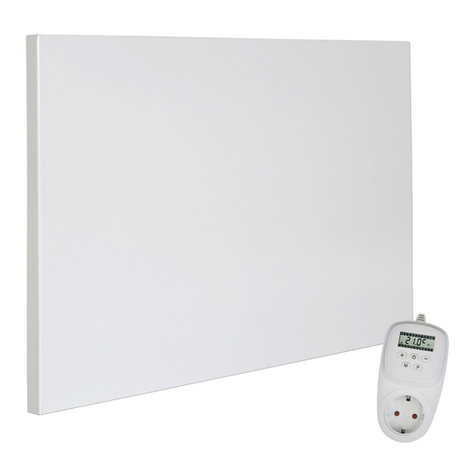
Viesta
Viesta H Series instruction manual

